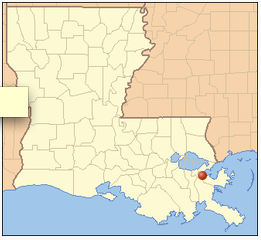| Home | Search | Emissions | Pollutants | About the Database |

Valero (1238), Meraux
LDEQ Accident Report
| Accident # | 151862 |
| State Police # | 13-04764 |
| Accident Date | 2013-10-25 |
| Report Date | 2013-11-01 |
| Follow-up Date | 2013-12-20 |
| Follow-up: | Yes |
Pollutants Released
| Pollutant | Duration | Point Source | Greenhouse Gas | Criteria Pollutant | Ozone forming chemical | Amount of Release |
| Crude Oil | 3h 11m | Crude unit heat exchanger | NO | NO | NO | 8,400.0 gallons |
| Benzene | 3h 11m | Crude unit heat exchanger | NO | NO | YES | 70.7 pounds |
Accident Classified As: Reportable Quantity
Cause of Problem: Equipment Design
At approximately 14:09 on 10/25/13, Valero experienced an unexpected release of crude oil when a stopple failed on a Crude Unit heat exchanger while a third party specialty contractor was working to install a bypass. A stopple is a device that isolates equipment for maintenance when a block valve is unavailable. The pressurized crude oil was released in an upward direction for approximately 15 minutes. Although most of the crude oil released remained on site, some of the resulting spray traveled offsite with the wind and was deposited on nearby East St. Bernard Highway and vehicles traveling on the highway. This spray continued in a southwesterly direction and left small spots of crude oil over the exposed sides of Valero buildings and vehicles in the nearby parking lot. Valero's dock facility and a moored ocean-going barge were also covered with a light spotting of small crude droplets. Valero also reported a sheen on the Mississippi River from this release which had largely dissipated by the time containment booms could be deployed. Light spotting has also been reported on some vehicles and structures in the Belle Chasse area. The root cause of the stopple failure was an undersized nose plate. The nose plate is a metal disc slightly smaller than the inside diameter of the pipe that is wedged into the pipe perpendicular to the flow. A gasket is attached to the nose plate that provides a seal along the inner walls of the pipe. In this case, the undersized nose plate did not provide enough support for the gasket and the gasket failed. The stopple fabrication and installation was performed by a third party specialty contractor with extensive expertise in performing this type of work. This contractor also conducted an investigation and determined that the nose plate had been modified in the field on a previous job, but no records of this modification existed. Consequently, this nose plate remained in circulation as a "standard" nose.
Discharge Preventable - Yes
Notes/Remedial Actions
Valero immediately took steps to shut off the Crude charge pumps and all nearby unit heaters. The crude oil continued to leak at a much lower rate as the system depressurized, but shortly after the crude pumps were shutdown, oil was no longer spraying off site. A mixture of crude oil and water continued to leak out onto the ground at a reduced rate until all sources of pressure were isolated at 17:20. Valero quickly mobilized contractors to clean up the highway and the barge moored at the dock. The highway was re-opened at 18:21 on 10/25/13 and the barge sailed the next day. Inside the refinery, free oil has been removed by vacuum truck and recovered. Clean-up efforts are on-going in the refinery and south of St. Bernard highway. To date these activities have included: 1) Wiping up visible oil with absorbent materials, 2) Cutting grass spotted with oil and collecting the clippings for disposal, 3) Applying Micro-Blaze Emergency Liquid Spill Control bioremediation agent to affected areas on the ground, 4) Washing spotted vehicles at an offsite location. Valero has provided car washes to the public as well. Air monitoring was conducted on and off site. Valero personnel donned breathing protection (full face respirators) when working in the immediate area of the release. Benzene readings of 0.15 ppm were briefly detected offsite along Valero's property line. Valero has worked closely with the third party contractor to develop corrective actions to prevent a reoccurrence of this event. The third party contractor has committed to: 1) train all stopple set-up technicians to review the findings and reiterate procedures and best practices. 2) inspect all nose plates in use and remove from circulation those that are out of tolerance, 3) implement a receipt inspection requirement to flag field modifications and initiate repair, and 4) modify the Hot Tap Critical step checklist to require the field technician to sigh off on key stopple measurements. Note: During the time of flaring, a citizen complaint was submitted on account of sulfur odor (Incident #151864). According to the environmental engineers from Valero, the odors likely came from Valero's waste water treatment plant, which was operating normally at the time.

Connect With Us: